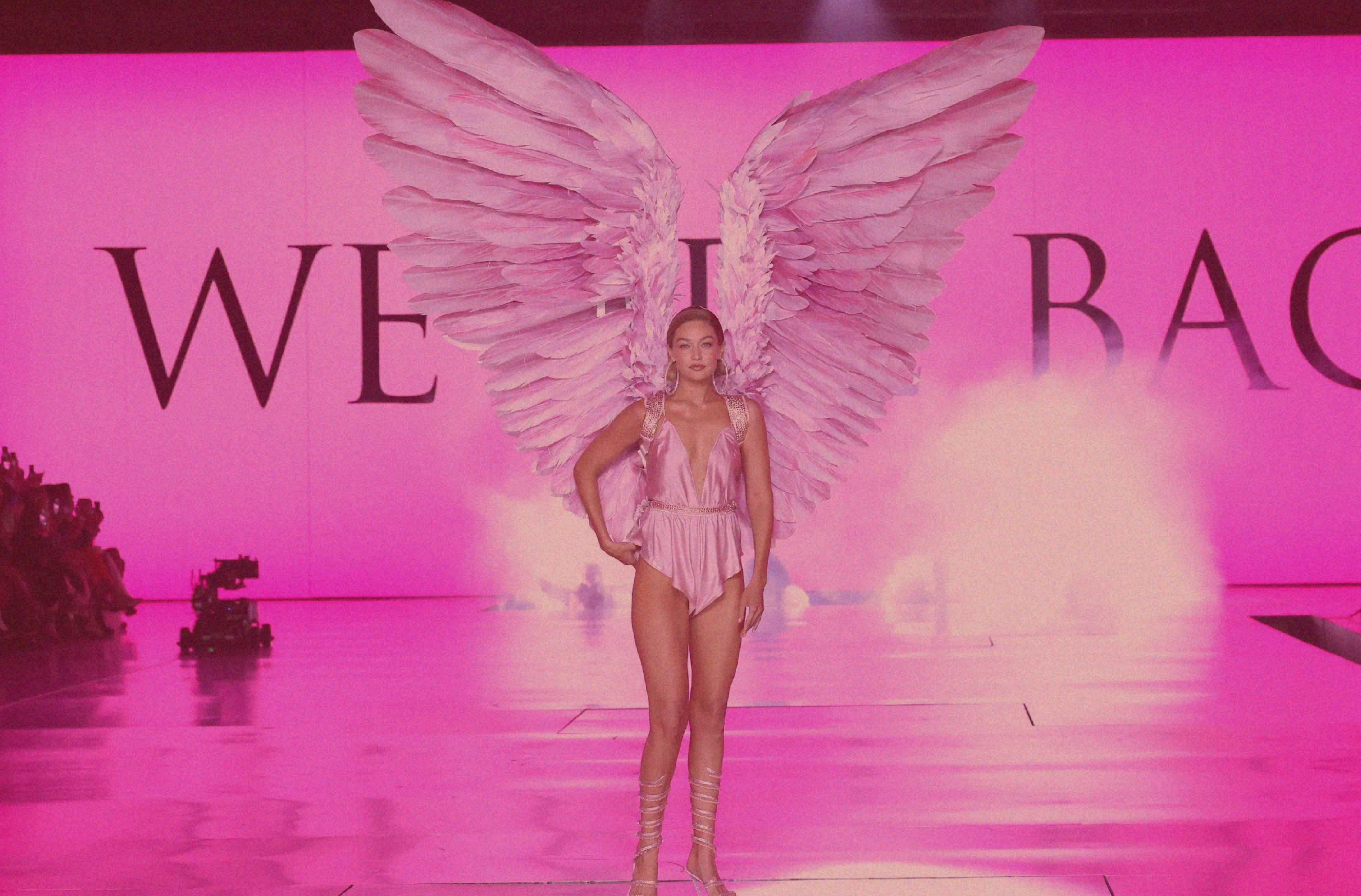
7 minute read
IN HONOR OF THE VICTORIAS SECRET FASHION SHOW RETURN
by Alissa Donovan
The return of the VS Fashion show comes during a time when, once again, thin is in. Over the past year, we have once again begun glorifying thin bodies while turning away from “body positivity” and “body neutrality.” The trends of the early 2000s came back, as did the obsession with hip bones, collarbones, and “pilates arms.” Although this seemingly seismic change within the industry initially frustrated me, I eventually swallowed a hard truth: the fashion industry was never body-positive, and I was kidding myself to think it ever was. Let’s take a walk down memory lane. There are two memories in my extremely short fashion “career” to prove that Devil Wears Prada was accurate in at least one regard: fashion is created for the thin.
The first instance was during my freshman year of fashion school. Within the first week, my class was told to select our very own dress form which would be ours for the remainder of the semester. On the surface level, dress forms are the body-like figures that fashion designers use to design clothing (i.e. mannequins). But selecting a dress form felt like an intimate experience; I understood that this dress form would be my sole companion on late-night studio visits, I would drape my first designs lovingly against its curves, and I would pin and unpin pieces of muslin with pencil ticks of measurements across it until the tips of my fingers bled. To me, the dress form felt like far more than a piece of equipment—it felt like the first tactical proof that I am a fashion designer.
I wanted to design clothing that I could wear, so I selected the largest dress form from the batch—a lonely size eight among a sea of size two and fours. I reasoned that I could make the clothes loose on the form and maybe I could squeeze the designs over my own body (rarely did that work). At the time, I was a size 12, a few sizes smaller than the average women’s dress size (which is somewhere between 16 and 20), and even as a size 12, I did not have a model form that reflected my own body. The result was that I, as a young fashion designer, was taught only how to dress a thin body. This is a truth that did not resonate in my mind at the time, as I was preoccupied with the unfairness that was pointed at me—a designer unable to create clothes for herself! Imagine!
The second instance was my senior year of undergrad when I worked as a Fashion Week intern at a popular Chelsea showroom. I was paid $20 a day for two weeks to help dress models, manage appointments with buyers, and primarily to make coffee for anyone who asked. (It is important to note that I would only receive my payment of $20/ day if I survived the full two weeks, which many interns did not). The showroom as a workplace was endlessly toxic. It felt that everyone was constantly on a diet—the only food to be found in the office was green juice (the team’s breakfast of choice), black coffee (made by me), and a large green salad that was catered for the interns every single day (a protein-less, light dressing salad which we ate while standing up because we were not allowed breaks).
But, to me, the most toxic behavior was not how we were overworked and underpaid (illegally, might I add); it was that we were required to wear the sample designs of the showroom, all of which were a size two. When the owner of the showroom told the interns that we would select something from the extra samples to wear every day, every intern but myself squealed with excitement. When the others peeled off from the meeting to get first dibs on their favorite samples, I pulled the owner aside. The conversation, to the best of my memory, was as follows:
Me: The designs are beautiful, but I noticed that the sample size is a two, sometimes a four. I won’t be able to fit into that. Is it okay if I wear a black dress instead?
Owner: No. You are a fashion designer. Get creative.
One featured designer offered a “one size fits all” shirt which resembled a shapeless artist’s smock with a row of buttons trailing down the back. This is the item I selected on the first day, but after my hair got caught on the buttons (forcing a model to cut a chunk of my hair off with scissors after a buyer insisted that they wanted to see the shirt in the color I happened to be wearing), I decided I would wear my own fucking clothes. If they wanted to fire me, they could; I was sure I could find another way to make the whopping $200 I’d miss out on.
All this to say that fashion has always been for the thin. These stories happened during the peak of the body positivity movement in fashion. I started fashion school the same year that Ashley Graham was featured as the first plus-sized model in Sports Illustrated. I worked as a Fashion Week intern in that Chelsea showroom one year after Christian Siriano announced that he tripled his sales by offering extended sizing. The fashion industry was celebrating body positivity! size inclusivity! body neutrality! fat acceptance! Apparently, those working within the industry did not receive the good news.
It is easy and romantic to look back and sigh with longing for the ‘body positivity” phase of fashion. (“How can we go backward? Look at the progress we made!”) But that phase never existed—at least, not in a way that I experienced. Just like any other trend, body positivity fell off and the industry is free to continue its blatant celebration of thin bodies.
And let me be clear: the fashion industry as one unit does not reflect the views and real progress of individual designers, models, influencers, and conscious consumers. The fact remains that there is a large desire for extended sizing, and some designers are doing an incredible job filling that gap. For example, last week I attended an event where Sam Edelman and his wife, Libby, discussed the Sam Edelman brand’s path to success. An audience member asked how the brand’s devotion to size inclusivity played into the brand’s success (Sam Edelman has carried extended shoe sizing and wide calf options for years). Sam and Libby both noted that size inclusivity was everything to the brand’s success—there is a large percentage of shoppers who require extended sizing for shoes, and stepping up to fill that gap in the market is what helped the brand to succeed. Why, then, does a brand such as Sam Edelman who understands the power of size inclusivity in shoes refuse to offer above a size twelve in clothing? As Sam and Libby pointed out, the numbers show that inclusive sizing is a lucrative as well as socially important path for businesses, and it is endlessly puzzling to me that fashion companies still refuse to follow the money towards inclusive sizing in clothing.
In what tone should I wrap up these tangled thoughts? Renewed inspiration? Hopelessness? Exhaustion or indifference? That, I am not sure. What I will leave you with is this: the fashion industry does not like bodies that are not thin, but maybe asking the fashion industry to change its taste is a fool’s errand. Yes, the fashion industry’s view of bigger bodies is problematic: Anna Wintour called plus-sized women “little houses” and Karl Lagerfeld famously said, “no one wants to see curvy women.” However, the body positivity movement was not meant to be enveloped within the messy confines of the fashion industry; the fashion industry merely tapped into a social movement that it viewed as a trend with a capacity to make the industry money. I do have hope that as a society outside of the fashion industry, we are becoming more tolerant of all bodies. I am hopeful that we will raise our daughters in a more inclusive environment than the one we came into. But expecting to find body positivity in an industry that does not want us to love our bodies is misguided.










